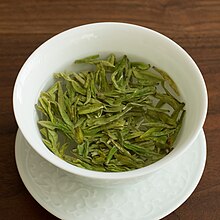 | |
| Type | Hot or cold beverage |
|---|---|
| Country of origin | China[1] |
| Introduced | First recorded in China in 59 BC, possibly originated earlier[2] |
Tea is an aromatic beverage prepared by pouring hot or boiling water over cured or fresh leaves of Camellia sinensis, an evergreen shrub native to East Asia which probably originated in the borderlands of southwestern China and northern Myanmar.[3][4][5] Tea is also made, but rarely, from the leaves of Camellia taliensis.[6][7][8] After plain water, tea is the most widely consumed drink in the world.[9] There are many different types of tea; some have a cooling, slightly bitter, and astringent flavour,[10] while others have profiles that include sweet, nutty, floral, or grassy notes. Tea has a stimulating effect in humans, primarily due to its caffeine content.[11]
An early credible record of tea drinking dates to the third century AD, in a medical text written by Chinese physician Hua Tuo.[12] It was popularised as a recreational drink during the Chinese Tang dynasty, and tea drinking subsequently spread to other East Asian countries. Portuguese priests and merchants introduced it to Europe during the 16th century.[13] During the 17th century, drinking tea became fashionable among the English, who started to plant tea on a large scale in British India.
The term herbal tea refers to drinks not made from Camellia sinensis. They are the infusions of fruit, leaves, or other plant parts, such as steeps of rosehip, chamomile, or rooibos. These may be called tisanes or herbal infusions to prevent confusion with tea made from the tea plant.
- ^ Fuller, Thomas (21 April 2008). "A Tea From the Jungle Enriches a Placid Village". The New York Times. New York. p. A8. Archived from the original on 14 February 2017. Retrieved 23 February 2017.
- ^ Mair & Hoh 2009, pp. 29–30.
- ^ Cite error: The named reference
Yamamotowas invoked but never defined (see the help page). - ^ Mary Lou Heiss; Robert J. Heiss. The Story of Tea: A Cultural History and Drinking Guide.
Camellia sinensis originated in southeast Asia, specifically around the intersection of 29th parallel and 98th meridian, the point of confluence of the lands of southwest China and Tibet
, north Burma, and northeast India, citing Mondal (2007) p. 519 - ^ Heiss & Heiss 2007, pp. 6–7.
- ^ "Laoshu Dianhong (Old Tree Yunnan)".
- ^ "Yunnan da Bai Silver Needles – Tea Trekker".
- ^ Liu et al. (2012)
- ^ Macfarlane, Alan; Macfarlane, Iris (2004). The Empire of Tea. The Overlook Press. p. 32. ISBN 978-1-58567-493-0.
- ^ Penelope Ody (2000). Complete Guide to Medicinal Herbs. New York: Dorling Kindersley Publishing. p. 48. ISBN 978-0-7894-6785-0.
- ^ Cappelletti, Simone; Piacentino, Daria; Sani, Gabriele; Aromatario, Mariarosaria (January 2015). "Caffeine: cognitive and physical performance enhancer or psychoactive drug?". Current Neuropharmacology. 13 (1): 71–88. doi:10.2174/1570159X13666141210215655. ISSN 1570-159X. PMC 4462044. PMID 26074744.
- ^ Martin, p. 29: "beginning in the third century CE, references to tea seem more credible, in particular those dating to the time of Hua T'o, a highly respected physician and surgeon"
- ^ Cite error: The named reference
caffwas invoked but never defined (see the help page).